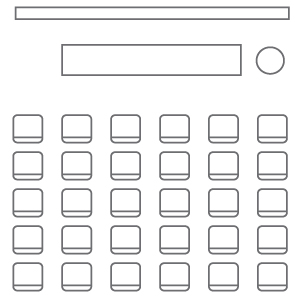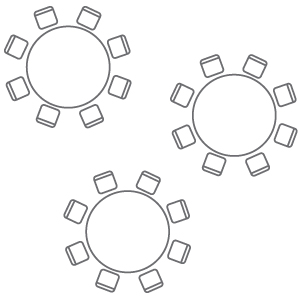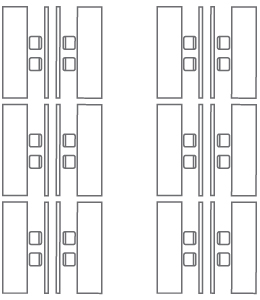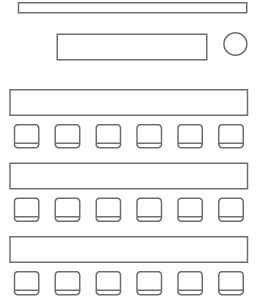October 7-10
Singapore
eLearn Presentation Types
FULL PAPERS: RESEARCH
& FULL PAPERS: PRACTICE-BASED

Presentation time: 25 minutes
Submission length: 6–10 pages (1875–4950 words); an abstract is not sufficient to be evaluated as a Full Paper.
Proceedings length: 6-10 pages
Papers present reports of significant work or integrative reviews in research, development, applications, and societal issues related to all aspects of the conference topics.
BRIEF PAPERS: RESEARCH
& BRIEF PAPERS: PRACTICE-BASED
 Presentation time: 15 minutes
Presentation time: 15 minutes
Submission length: 4-6 pages (1250-3750 words)
Proceedings length: 4-6 pages (1250-3750 words)
These papers are brief, more condensed presentations or work-in-progress projects.
The submission should clearly indicate:
- what is going to be shown or demonstrated or offered;
- the major aspects;
- the context or motivation;
- relevant URL’s or literature references.
PANELS
 Presentation time: 1 hour
Presentation time: 1 hour
Submission length: 2-6 pages (625-1875 words)
Proceedings length: 2-6 pages(1250-3750 words) for each paper
A Panel, consisting of 3 – 5 people (including the chair), present their views on a common theme, issue, or question, and then to discusses them with the audience.
The Panel must present an opportunity for the audience to hear well reasoned arguments and discussions about pertinent topics as seen from a variety of viewpoints. For example, ‘on-line testing’ could be a Panel discussion with panelists presenting arguments in support of, and in opposition to, testing.
Panels must include the audience. Thus, the panelists should take no more than 30, of the total 60 minutes, to make their case and then guide the audience through a discussion and series of questions and answers. In an effort to present differing viewpoints, it is a requirement that panelists can NOT all represent the same institution, research project, or association.
Panel selection will be based on the importance, originality, focus and timeliness of the topic; expertise of proposed panelists; as well as the potential for informative AND controversial discussion.
Panels must allot at least 50% of the time for interaction and discussion with the audience.
The Panel leader should provide an abstract describing the panel and a submission file with the following sections that describe the panel:
- introduction that links the theme to the literature and its significance for the field of information technology and education, around 150 word abstracts of each panelists’ perspective,
- list of panelists’ perspective titles and authors, with their organizations, and countries in the order they will be presented, and
- outline of how the panel will be organized. After acceptance, the Panel coordinator will be given the option to invite Panel authors to submit their papers to a specific web site. Until then, authors should NOT submit their individual papers for the Panel. Contributing authors may choose to publish their papers in the Proceedings as a Full or Brief Paper. The Panel abstract will only appear in the conference Abstract book.
ROUNDTABLES
 Presentation time: 1 hour
Presentation time: 1 hour
Submission length: 2-6 pages (625-1875 words)
Proceedings length: 2-6 pages (1250-3750 words)
AV equipment provided: WiFi, roundtable, electricity when available – upon request
These sessions allow maximum interaction in informal, small-group discussions on a single topic. The format is appropriate for papers, projects, or work-in-progress that encourage discussion. Roundtables share a room with 3-5 other concurrently held Roundtables.
If you wish to bring a laptop pr device, you could demonstrate a new piece of software, illustrate the process of using it, show participants some of the complexities and tricks about it, and give them an opportunity to try it themselves.
Internet (via your wireless card) will be provided. A screen and projector will not be provided as this is an informal small group discussion environment not conducive for projecting images from a distance.
These sessions are also appropriate for discussion of instructional strategies, procedures, and evaluation procedures. The idea is not to give a definitive workshop on the topic but to provide participants with enough information to help them decide whether their needs can be met with the program or procedure.
If software is to be discussed, include a description of the software and the objectives of the session proposal.
POSTER / DEMONSTRATIONS
 Presentation time: 2 hours
Presentation time: 2 hours
Submission length: 2-6 pages (1250- 1875 words)
Proceedings length: 4-6 pages (1250-3750 words)
AV equipment provided: 4’x8′ poster board, 6′ table, 2 chairs, WiFi
Poster/Demonstration sessions enable researchers and non-commercial developers to demonstrate and discuss their latest results and developments in progress in order to gain feedback and to establish contact with similar projects.
Poster/Demonstration proposals must include:
- Description of the planned Poster/Demonstration; should emphasize the problem, what was done, and why the work is important
Poster/Demonstration presenters will be required to arrange for their own systems software and hardware.
INNOVATORS PLAYGROUND EXHIBITS

Presentation time: 2 hours
Submission length: 1-2 paragraphs, Logo/Graphic & URL required with submission
Proceedings length: 150 words (published only in Conference online schedule)
Demonstrate and discuss your company’s products, services, developments, applications and research, inform the audience of your future directions, gain feedback, and establish contacts. Presentation rooms generally accommodate 250 people, exhibit-style.
Attendees can experience hands-on activity with the top creative and learning technologies in an interactive space.
Practitioners will share activities, tools, curriculum currently experiencing success using at their institution!
Exhibitors have the outstanding opportunity to connect one-on-one with 1,200+ decision makers and influencers from over 60+ countries in the field of education!
WORKSHOPS
 Presentation time: 3.5 or 7 hours
Presentation time: 3.5 or 7 hours
Submission length: 2-6 pages (625-1875 words)
Proceedings length: no pages
Workshops are intended to enhance the skills and broaden the perspective of their attendees. They should be designed to introduce a rigorous framework for learning a new area or to provide advanced technical training in an area. Submissions will be selected on the basis of the instructors’ qualifications for teaching the proposed Workshop and their contribution to the overall conference program.
Equipment Note: An instructor PC, projector, screen and WIFI will be provided for the room. Due to the extra expense required, a lab of computers cannot be furnished. If your Workshop is hands-on, please state what equipment you will bring or that participants should BYOL-Bring Your Own Laptop.
Workshop proposals must include:
- Clear description of the objectives
- Intended audience (experience level and prerequisites)
- Proposed length (3 hours or 6 hours)
- 200-word abstract
- 1-page topical outline of the content
- Summary of the instructor’s qualifications
SYMPOSIA
 Presentation time: 2 hours
Presentation time: 2 hours
Submission length: 4-6 pages (1250-3750 words)
Proceedings length: 4-6 pages (1250-3750 words) for each paper
A Symposium is a collection of Full and/or Brief Papers on a theme that has been coordinated and led by the symposium’s leader(s). Each Symposium that is accepted will be allocated two adjacent hour-long slots in the conference program.
The Symposium leader should provide an abstract briefly describing the symposium and a submission file with the following sections:
- introduction that links the theme to the literature and its significance for the field of information technology and education, around 150 word abstracts of each paper,
- list of paper titles and authors, with their organizations, and countries in the order they will be presented and indicating which will be presented the first and second hours, and
- outline of how the symposium will be organized.
After acceptance, the Symposium coordinator will be asked to invite Symposium authors to submit their papers to a specific web site. Until then, authors should NOT submit their individual papers for the Symposium.
Contributing authors may choose to publish their papers in the Proceedings as a Full or Brief Paper. The Symposium abstract will only appear on the online conference platform.
VIRTUAL PAPERS

In consideration of presenters who may be unable to attend E-Learn in person due to funding or time constraints, Virtual Presentations have been added to the program with the same validity (publication, certification, etc.) as the face-to-face (F2F) conference and with the capability to interact with session participants.
Why a Virtual Presentation?
- Saves money. No travel, accommodation, and restaurant costs
- Saves time. No travel or away time required.
- Allows you to participate when you schedule your time to do so.
- Same validity as the face-to-face (F2F) conference (publication, certification, etc.).
- Paper published in the LearnTechLib Digital Library proceedings.
- Publish and share all supporting media (PPT, video, etc.) in the proceedings.
- Capability to interact with your session’s participants (async) prior to, during and after the event.
- Participate in all conference session discussions (async).
- Viewing of keynote and invited speaker talks.
- Virtual presentations are green!
- And more…
Presentation time: 30 minutes
Submission length: 4-6 pages
Proceedings length: 4-6 pages
Virtual Paper sessions enable research, developers, and practitioners to present and asynchronously discuss, via the conference website and online Discussion board, their latest results and developments in progress in order to gain feedback and to establish contact with similar projects.
These papers are brief, more condensed presentations or work-in-progress projects. These sessions also may be new extensions to existing projects, newly initiated projects, and/or projects underway that include opportunities for additional partners.
Virtual Paper proposals must include:
- Description of the planned Paper should emphasize the problem, what was done, and why the work is important
The submission should clearly indicate:
- what is going to be shown or demonstrated or offered
- the major aspects
- the context or motivation
- relevant URLs or literature references
To be included in the Final Program, accepted Virtual Presenters must register by the confirmation deadline and submit their PPT or PPTX (without audio or video) presentation file. All presentation files will be reviewed.
All virtual sessions are presented asynchronously. Accepted submission authors will be sent instructions on how to record optional audio for their uploaded PowerPoint slides. This recording is encouraged but not required. Authors will also have access to all conference papers and PPTs via AcademicExperts.org. Virtual presenters are required to post an opening comment/question on their presentation page, and respond to attendee feedback during the conference week.